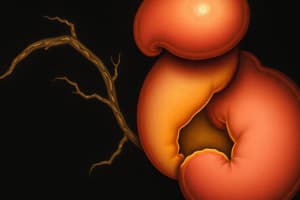Podcast
Questions and Answers
What role does the primitive streak play in embryogenesis?
What role does the primitive streak play in embryogenesis?
- It defines the endpoint of cell migration.
- It allows for the differentiation of ectoderm layers.
- It is responsible for establishing the body axes of the embryo. (correct)
- It serves as the site for early embryonic organ development.
What is the primary role of Hensen's node in early embryo development?
What is the primary role of Hensen's node in early embryo development?
- It creates the outer layer of the ectoderm.
- It is responsible for the digestion of maternal nutrients.
- It serves as a signaling center for mesoderm differentiation. (correct)
- It induces the formation of the neural tube.
Which statement accurately describes Hensen's node?
Which statement accurately describes Hensen's node?
- It is equivalent to the organizer in amphibian development. (correct)
- It generates signals that lead to the formation of epithelial tissue.
- It marks the location for endoderm cell migration.
- It is located at the caudal end of the primitive streak.
How do cells in the epiblast prepare to migrate through the primitive streak?
How do cells in the epiblast prepare to migrate through the primitive streak?
What occurs during the first wave of cell migration through the primitive streak?
What occurs during the first wave of cell migration through the primitive streak?
What characterizes the mesenchyme during gastrulation?
What characterizes the mesenchyme during gastrulation?
Which of the following describes the process by which cells migrate during the formation of the primitive streak?
Which of the following describes the process by which cells migrate during the formation of the primitive streak?
What is the consequence if migratory streak cells fail to lose E-cadherin during EMT?
What is the consequence if migratory streak cells fail to lose E-cadherin during EMT?
What spatial organization is primarily established at the formation of the primitive streak?
What spatial organization is primarily established at the formation of the primitive streak?
What happens to cells that undergo a Mesenchymal to Epithelial Transition (MET) during development?
What happens to cells that undergo a Mesenchymal to Epithelial Transition (MET) during development?
What characterizes the cadherin family members involved in cell migration during embryogenesis?
What characterizes the cadherin family members involved in cell migration during embryogenesis?
How often do somites form in mouse embryos during development?
How often do somites form in mouse embryos during development?
What is a likely outcome if the cadherin expression is significantly altered during embryonic development?
What is a likely outcome if the cadherin expression is significantly altered during embryonic development?
What is a key function of the cells migrating through the primitive streak?
What is a key function of the cells migrating through the primitive streak?
What determines the location of the primitive streak within the embryonic disc?
What determines the location of the primitive streak within the embryonic disc?
What is the main type of cellular transition involved when epiblast cells migrate through the primitive streak?
What is the main type of cellular transition involved when epiblast cells migrate through the primitive streak?
What is the primary role of the hypoblast in early embryonic development?
What is the primary role of the hypoblast in early embryonic development?
Which statement best describes the function of cadherins in epithelial cells?
Which statement best describes the function of cadherins in epithelial cells?
Which cells will ultimately make up the entire embryo?
Which cells will ultimately make up the entire embryo?
What is the characteristic arrangement of epithelial cells in early embryonic development?
What is the characteristic arrangement of epithelial cells in early embryonic development?
What is the significance of Hensen's node during body axis establishment?
What is the significance of Hensen's node during body axis establishment?
What process allows epithelial cells to change into a more motile mesenchymal form during development?
What process allows epithelial cells to change into a more motile mesenchymal form during development?
What is true regarding the relationships between epithelial cells and their extracellular matrix?
What is true regarding the relationships between epithelial cells and their extracellular matrix?
Which statement accurately describes the cells of the trophoblast?
Which statement accurately describes the cells of the trophoblast?
Flashcards
Epithelial-to-Mesenchymal Transition (EMT)
Epithelial-to-Mesenchymal Transition (EMT)
A cellular process where epithelial cells lose their characteristics and become migratory mesenchymal cells.
Mesenchyme
Mesenchyme
A loosely arrayed tissue with abundant extracellular matrix, supporting cell migration.
Primitive Streak
Primitive Streak
A structure in early embryonic development where cells migrate to form various tissues.
E-cadherin
E-cadherin
Signup and view all the flashcards
Somites
Somites
Signup and view all the flashcards
Gastrulation
Gastrulation
Signup and view all the flashcards
Mesoderm
Mesoderm
Signup and view all the flashcards
Mesenchymal-to-Epithelial Transition (MET)
Mesenchymal-to-Epithelial Transition (MET)
Signup and view all the flashcards
Hypoblast Formation
Hypoblast Formation
Signup and view all the flashcards
Hypoblast's Epithelial Nature
Hypoblast's Epithelial Nature
Signup and view all the flashcards
Blastocoel's Transformation
Blastocoel's Transformation
Signup and view all the flashcards
Epiblast Definition
Epiblast Definition
Signup and view all the flashcards
Epiblast's Embryo Origin
Epiblast's Embryo Origin
Signup and view all the flashcards
Extraembryonic Membranes
Extraembryonic Membranes
Signup and view all the flashcards
Basement Membrane Formation
Basement Membrane Formation
Signup and view all the flashcards
Cadherins and Cell Adhesion
Cadherins and Cell Adhesion
Signup and view all the flashcards
Cadherin binding properties
Cadherin binding properties
Signup and view all the flashcards
Differential cadherin expression
Differential cadherin expression
Signup and view all the flashcards
Primitive (Hensen's) node
Primitive (Hensen's) node
Signup and view all the flashcards
Body axis establishment
Body axis establishment
Signup and view all the flashcards
Definitive endoderm
Definitive endoderm
Signup and view all the flashcards
Mesoderm formation
Mesoderm formation
Signup and view all the flashcards
Embryonic disc
Embryonic disc
Signup and view all the flashcards
Study Notes
Chapter 5: Gastrulation; establishment of embryonic germ layers and early patterning
- Key terms: Axis specification, body axes, cilia, pattern formation, blastocyst (blastula), hypoblast, inner cell mass, trophoblast (trophectoderm), embryonic germ layers (mesoderm, endoderm, ectoderm), gastrula, gastrulation, E-cadherin, mesenchyme, mesenchymal, epithelial cells, epithelium, epithelial-mesenchymal transition (EMT), notochord, anterior/posterior, dorsal/ventral, extra-embryonic tissues (membranes), prechordal plate, primitive node, primitive streak, cloacal membrane, buccopharyngeal membrane
Learning Objectives
- Name the three germ layers of the embryo established during gastrulation and give two examples of adult tissues that arise from each.
- Describe "axis specification" and give an example of axis specification occurring during gastrulation.
- Identify the embryonic germ layer that gives rise to the notochord and describe its role in early development.
- Explain the process of establishing right/left body axis patterning, including the role of cilia.
- Differentiate between mesoderm and mesenchyme.
- Describe the epithelial-mesenchymal transition (EMT) and name one important molecule in this transition.
- Explain the importance of "pattern formation" in embryogenesis and describe potential consequences of abnormal patterning.
Gastrulation
- Gastrulation is a stage of embryonic development where the embryo establishes the three germ layers (endoderm, ectoderm, and mesoderm) that will form all adult tissues.
- Body axes (cranial/caudal, left/right, dorsoventral) are patterned during gastrulation.
- Morphogenesis is the process of structure building, occurring during gastrulation.
- Initially, the embryo consists of the inner cell mass and trophoblast/trophectoderm.
- Inner cell mass cells migrate to the underside of the embryonic disc, detaching and forming the hypoblast (later endoderm).
- Hypoblast expands to line the blastocoel/yolk sac.
- The epiblast cells form the remaining embryo.
- Cadherins are cell adhesion molecules that help establish tissue structure and are important in gastrulation.
Gastrulation-Cells Migrate
- Cells of the inner cell mass migrate, detach from the disc, arrange into a sheet (hypoblast), expanding to form the interior of the blastocoel(yolk sac)
- Scattered cells migrate to the underside of the disc, detach, and arrange themselves into a sheet called the hypoblast.
- The hypoblast will later become the endoderm.
- The remaining cells of the inner cell mass are called the epiblast and these form the embryo.
Cell Migration into Primitive Streak
- Epiblast cells migrate towards the midline forming a groove called the primitive streak.
- Cells lose epithelial characteristics and become migratory through an epithelial-to-mesenchymal transition (EMT), driven by the loss of E-cadherin.
Formation of Notochord and Prechordal Plate
- The notochord is a mesodermal structure crucial for vertebrate development.
- Mesodermal cells from Hensen's node migrate cranially forming the notochord.
- Notochord runs along the midline, between the ectoderm and endoderm.
- Prechordal plate is mesoderm cranial to the notochord, and important for head development.
- It forms at the cranial end of the embryo.
Buccopharyngeal and Cloacal Membranes
- These membranes are formed by the fusion of ectoderm and endoderm.
- These membranes separate the digestive tube from the external environment at the mouth and anus. (later degenerate).
Completion of Gastrulation
- The embryonic disc, at this point, has three germ layers: ectoderm, mesoderm, and endoderm.
- Body axes have been established.
Studying That Suits You
Use AI to generate personalized quizzes and flashcards to suit your learning preferences.




